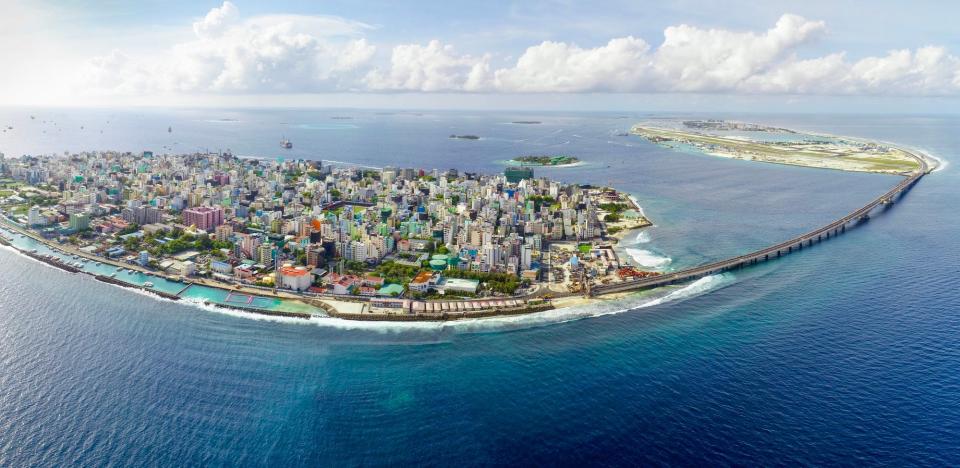Why is India unnerved about the visit of a Chinese research ship in its backyard?
A Chinese research vessel has been given permission to make a port call in the Maldives. The stop, which authorities said was for resupplying purposes, is likely to heighten tensions in the region, particularly with India.
The Maldives government announced on Tuesday that the Xiang Yang Hong 3, which had earlier been turned down by Sri Lanka, was given permission for the port call. It is expected to dock at Male Sea Port on February 5.
The permission was limited to "rotation of personnel and replenishment" purposes only, and the vessel is not allowed to carry out any research in Maldivian waters, according to the island nation's foreign ministry.
Do you have questions about the biggest topics and trends from around the world? Get the answers with SCMP Knowledge, our new platform of curated content with explainers, FAQs, analyses and infographics brought to you by our award-winning team.
India's navy will monitor the ship's entire journey in the region "to ensure that it does not carry out any exploration activity in the Maldivian exclusive economic zone", the Hindustan Times reported.
India has labelled the Xiang Yang Hong 3 a "Chinese spy ship" and expressed its concerns over its "surveillance activity" to Sri Lanka and the Maldives last year.
Commissioned in 2016, the Xiang Yang Hong 3 is operated by China's Ministry of National Resources. With an operational range of 15,000 nautical miles (27,780km), the Xiang Yang Hong 3 can remain at sea for up to 60 days.
The ship is equipped with advanced ocean research facilities and has played a key role in China's oceanic research, mainly in the Pacific and Indian oceans.
The vessel can also house temporary laboratory modules for specific missions, according to a report by Science and Technology Daily. Its "integrated optical cabin" is loaded with cutting-edge cameras, sensors and laser markers to record imagery, make precise measurements and gather complex data.

In a move that has upset India, the Maldives will host a Chinese research vessel at the Male Sea Port from February 5. Photo: Xinhua alt=In a move that has upset India, the Maldives will host a Chinese research vessel at the Male Sea Port from February 5. Photo: Xinhua>
Although the Xiang Yang Hong 03 is not a military vessel, India has been suspicious about its activities in the Indian Ocean. In January 2021, Indian media reported the ship had been "mapping the sea floor, probably with underwater drones" in the East Indian Ocean, and collecting data that could aid Chinese submarine activities in the region.
The vessel returned to the Indian Ocean region in June 2022, and again in late 2023.
The Indian Ocean has become a frequent destination for Chinese scientific research ships.
The Xiang Yang Hong, or "Facing the Red Sun", vessels are a class of survey and research ships that also includes the Xiang Yang Hong 1, 6 and 19 - all of which have been reported to be operating in the same region.
The Shi Yan, or "Experiment" ships, run by the Chinese Academy of Sciences, is another fleet of China's active survey vessels. In 2019, India said its navy expelled the Shi Yan 1 from India's exclusive economic zone in the Andaman Sea, claiming the ship was "spying" on its military.
Other Chinese research vessels have also drawn India's ire, including the Yuan Wang, or "Looking Far", fleet, part of the Strategic Support Force under the People's Liberation Army. It is often sent to the Indian Ocean to track and monitor Chinese space launches.
In August 2022, the Yuan Wang 5 survey ship visited Hambantota International Port in Sri Lanka to resupply. Late last year, Colombo hosted the research ship Shi Yan 6, which conducted a joint maritime survey in Sri Lankan waters.
In recent decades, China has vastly increased its presence in the Indian Ocean through naval patrols, economic activities, and scientific research, all of which India sees as a threat in its backyard. Since a deadly border clash in 2020, the two Asian giants have stepped-up their competition for influence in the region.
But the new Maldivian president, Mohamed Muizzu, is regarded as more Beijing-friendly. Days after his state visit to China - and amid a diplomatic spat with India - he asked for the removal of Indian troops stationed in his nation.
"The Maldives has always been a welcoming destination for vessels of friendly countries, and continues to host both civilian and military vessels making port calls for peaceful purposes," the Maldivian foreign ministry said, referring to the Xiang Yang Hong 3 visit.
Sri Lanka, on the other hand, under diplomatic pressure from India, has since banned any further visits by Chinese research vessels, and prohibited them from operating within its exclusive economic zone for all of 2024. The move has been hailed by Indian media as a "victory" over China.
This article originally appeared in the South China Morning Post (SCMP), the most authoritative voice reporting on China and Asia for more than a century. For more SCMP stories, please explore the SCMP app or visit the SCMP's Facebook and Twitter pages. Copyright © 2024 South China Morning Post Publishers Ltd. All rights reserved.
Copyright (c) 2024. South China Morning Post Publishers Ltd. All rights reserved.

 Yahoo Finance
Yahoo Finance 